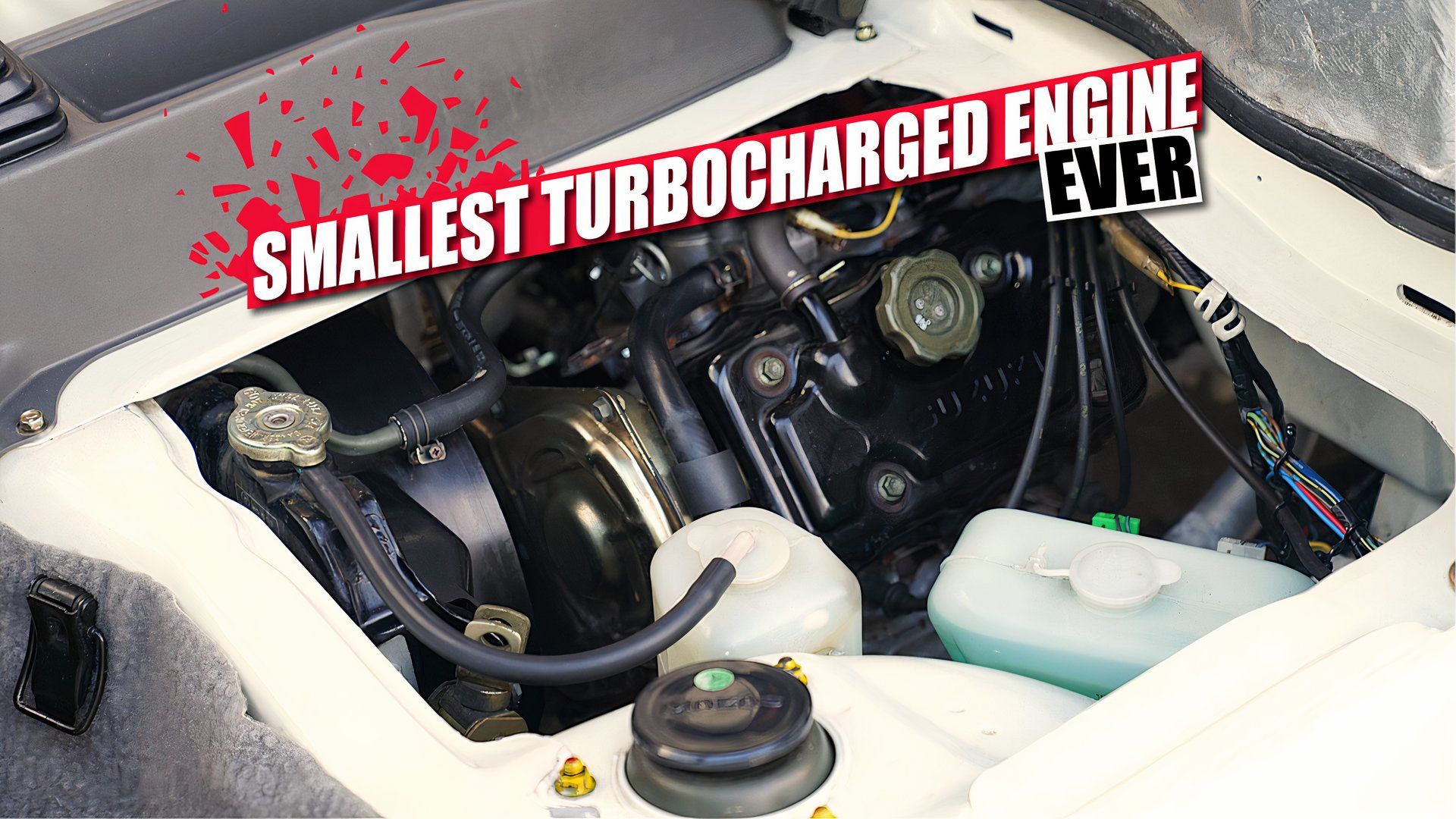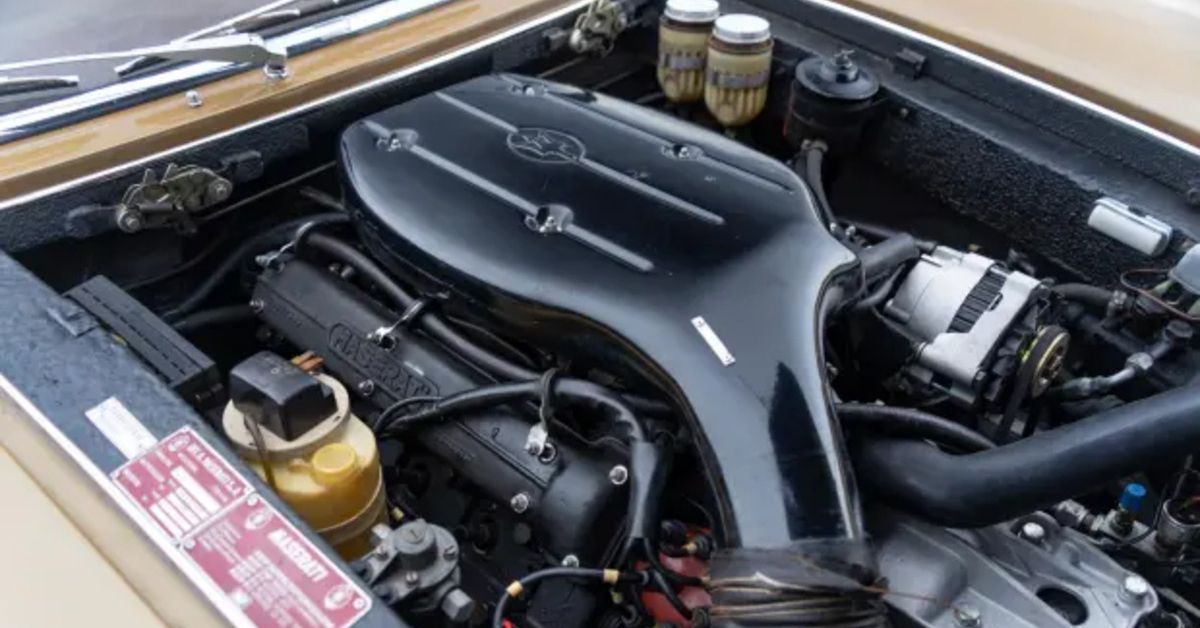What do a BMW M3, many recent Ferraris, and a diesel Vauxhall Insignia all have in common? Aside from the fact they have four wheels and an engine, the common link between this eclectic range of automobiles is the fact that they have twin turbochargers. In a bid to improve efficiency in modern engines, and to help eradicate turbo lag that would put you in a fence mid-corner, the use of a pair of turbochargers has become commonplace in most sectors of the car world.
But, back in the ’80s, even turbocharging was a fairly new idea, generally only applied to the wildest Audis, Porsches, BMW, and Saab models the company had to offer, accompanied by equally lairy graphics to advertise the forced induction within. Four decades ago, twin turbochargers were virtually unheard of, but there was one company that brought out a car with this tech in 1981 – way ahead of the competition.
What’s more, not only was this a niche brand that was a rare sight on the roads, but also the car in question was a strange blend of boxy styling and supercar pedigree. These groundbreaking cars are also incredibly cheap to buy these days but may require new owners to buy a box of Brave Pills before purchase. If you have the stomach for it, you can also own an exotic pioneering twin-turbo sports car for the price of a second-hand Ford Focus.

Related
This Is The Smallest Turbocharged Engine Ever In A Production Car
Barely displacing the equivalent of a pint, this Japanese 3-cylinder powerplant is the smallest ever turbocharged engine in a production car.
The Maserati Biturbo Was The First-Ever Twin-Turbocharged Production Car
1984 Maserati Biturbo Specs
|
Engine |
Twin-turbocharged 2.0-liter V6 |
|
Power |
180 hp @ 6,000 rpm |
|
Dry Weight |
2,394 lbs |
|
0 to 60 mph |
6.5 seconds |
|
Top Speed |
134 mph |
Source: Maserati
In the ’60s and ’70s, the Italian firm Maserati carefully made its name by producing exquisite sports cars. Thanks to models such as the Merak, Bora, and Ghibli, the brand was up there with Ferrari and Porsche as a quintessential performance car manufacturer. Some would argue the name ‘Maserati’ sounded even more evocative. It was a name you could mutter down the Casino de Monte-Carlo in between hands of Black Jack and people would know you had a discerning taste rather than being one of the nouveau riche.
Maserati Decided It Didn’t Need Its Exotic Reputation In The ’80s
As the ’70s turned into the ’80s, Maserati owner Alejandro De Tomaso had a new idea. Rather than focus on achingly beautiful supercars to shift units, Maserati would introduce a new model to attract more customers. Calling in designer Pierangelo Andreani, the man responsible for the Fiat Ritmo and later, the Fiat Chroma Station Wagon, Maserati created the Biturbo.
Gone were the swooping lines and wedge shapes, this was a car that would be a doddle to turn into a LEGO set – such was its angular three-box design. It looked a little like the soon-to-be-launched E30 3 Series, which would spawn the legendary M3, and ushered in a new era for Maserati. It would become the mainstay of the company too, being sold in one form or another until 1994.
Boxy Styling Meets Pioneering Tech
The boxy body style was perhaps very much of its era, not that much different from Audi Coupes and Lancia Deltas, and while not unattractive, it didn’t really live up to the haute couture supercar image that Maserati’s brand had cultivated for years. That is until you looked under the bonnet.
Here was an engine that was as cutting edge as it was exotic. This was a compact,1,996cc V6 with not one but two turbochargers, at a time when Audi had just wowed the world with its groundbreaking Quattro that featured a single turbocharger. The Biturbo’s pioneering power plant was matched to a luxurious interior to create what Maserati hoped would be an everyday car.
A Closer Look At The Biturbo’s Unique Engine
The Maserati Biturbo
was launched in December 1981. The Biturbo’s engine was a new, compact 90-degree V6 that benefitted from induction via two small turbochargers. Maserati’s idea to add two turbochargers was the world’s first on a production car and way ahead of its time.
The original Biturbo had a dinky 2.0-liter six-cylinder, with three valves per cylinder (two intake, one exhaust), a single overhead camshaft, and two turbos. The parallel twin-turbo system meant the turbos worked together, although each had its own cylinder bank. The idea was that two smaller turbochargers could spool up quicker than one larger, reducing turbo lag common on many early forced induction cars.

Google News
Enjoying the content? Consider adding HotCars to your Google News feed.
The Biturbo Doesn’t Have Much Power, But It’s Still Quick
At this point, you might be thinking that it was, in the same vein as downsizing and turbocharging cars is today, a good way to create power and fuel efficiency. You’d be slightly wrong on both counts. The V6 twin-turbo engine only produced 180 horsepower at 6,000 rpm, but with just 2,394 lbs to haul around, this was good for hitting 60 mph in 6.5 seconds and a top speed of 134 mph. Official economy figures are hard to come by but when one well-known magazine tested a later, 2.5-liter Biturbo in 1986 they managed 11 mpg.
In 1983, the more powerful Biturbo S was introduced, featuring twin intercoolers, which were noticeable by the two NACA air ducts on the hood. In 1986 and 1987, both models were upgraded with fuel injection as the 187 horsepower Biturbo i and 220 horsepower Biturbo Si. There were two versions made: a 1,996 version for the domestic market which avoided VAT on engines over 2.0 liters and a 2.5-liter, and later 2.8-liter for the export market.
The Maserati Biturbo Was A Hit
It would be easy to look at the Biturbo as the car that turned Maserati from a maker of beautiful exotica to wannabe BMWs that were, according to road testers at the time, not that easy to drive. This is in part true, but the Biturbo did see Maserati shifting quite a few cars, too.
The Biturbo did open Maserati up to a new audience and to look at the interiors now, with seats that look as inviting as a Soriana sofa, it is no wonder that people wanted to sit inside this new type of Maserati. There was also a Spyder version, the first open Maserati since the Ghibli Spyder more than 12 years earlier. Zagato took care of the Spyder’s development, with the Biturbo’s 2,514 mm wheelbase shortened to 2,400 mm for the convertible models.
Maserati Sold Almost 40,000 Biturbos
The Biturbo also evolved into hard-hitting super sports models such as the Ghibli and stunning Shamal in the ’90s. In the end, according to Hemmings.com, more than 38,000 Biturbos were built in the platform’s dozen years of life, with more than 5,000 making it to the States. Maserati then spent the next three decades trying to rebuild its reputation as a serious sports and supercar manufacturer with models such as the Coupé and Spyder, GranCabrio, and GranTurismo, and the excellent value MC20 reviving the brand.

Related
Maserati’s Masterpieces: The Top 10 Engines In Their Storied History
This Italian manufacturer is famous for creating some gorgeous classics to rival the best; here are the magnificent engines that power them.
The Maserati Biturbo Is A Twin-Turbo Bargain Today
Maserati Biturbo Prices In 2025 (Good Condition)
- 1984 Maserati Biturbo Base – $4,900
- 1985 Maserati Biturbo – $4,900
- 1987 Maserati Biturbo – $5,200
- 1989 Maserati Zagato (Spyder) – $13,800
- 1991 Maserati Biturbo – $13,800
- 1992 Maserati Zagato (Spyder) – $15,000
Source: Hagerty Valuation Tool
Considering its groundbreaking engine and badge, it may come as some surprise to learn that the Biturbo is a used car bargain. An early 1984 Maserati Biturbo in good condition costs, according to Hagerty Valuation Tools, just $4,900, or roughly the same price as a 2012 Ford Focus.
We found this 1987 Biturbo Spyder with just 27,000 miles on the clock which sold in December 2024 for just $7,500. Not a lot of money for a pretty car. Also, it’s worth considering when you are next window shopping for a BMW 325i Convertible of the same year, which will cost an average of $16,300, according to Hagerty, but doesn’t sound anywhere near as good in the casino.
Sources: Hagerty.com; Hemmings.com; Maserati.com













